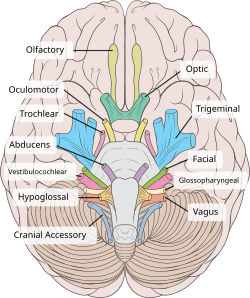Accessory nerve
| Accessory nerve | |
|---|---|

Diagram of the upper portions of the glossopharyngeal, vagus, and accessory nerves.
|
|

Inferior view of the human brain, with the cranial nerves labelled.
|
|
| Details | |
| Innervates | sternocleidomastoid muscle, trapezius muscle |
| Identifiers | |
| Latin | nervus accessorius |
| MeSH | A08.800.800.120.060 |
| TA | A14.2.01.184 |
| FMA | 6720 |
|
Anatomical terms of neuroanatomy
[]
|
|
The accessory nerve is a cranial nerve that supplies the sternocleidomastoid and trapezius muscles. It is considered the eleventh of twelve pairs of cranial nerves, or simply cranial nerve XI, as part of it was formerly believed to originate in the brain. The sternocleidomastoid muscle tilts and rotates the head, while the trapezius muscle has several actions on the scapula, including shoulder elevation and abduction of the arm.
Traditional descriptions of the accessory nerve divide it into a spinal part and a cranial part. The cranial component rapidly joins the vagus nerve, and there is an ongoing debate about whether the cranial part should be considered part of the accessory nerve proper. Consequently, the term "accessory nerve" usually refers only to nerve supplying the sternocleidomastoid and trapezius muscles, also called the spinal accessory nerve.
Strength testing of these muscles can be measured during a neurological examination to assess the function of the spinal accessory nerve. Poor strength or limited movement are suggestive of damage, which can result from a variety of causes. Injury to the spinal accessory nerve is most commonly caused by medical procedures that involve the head and neck. Injury can cause wasting of the shoulder muscles, winging of the scapula, and weakness of shoulder abduction and external rotation.
The accessory nerve is derived from the basal plate of the embryonic spinal segments C1–C6.
The fibers of the spinal accessory nerve originate solely in neurons situated in the upper spinal cord, from where the spinal cord begins at the junction with the medulla, to the level of about C6. These fibers join to form rootlets, roots, and finally the spinal accessory nerve itself. The formed nerve enters the skull through the foramen magnum, the large opening at the skull's base. The nerve travels along the inner wall of the skull towards the jugular foramen. Leaving the skull, the nerve goes through the jugular foramen with the glossopharyngeal and vagus nerves. The spinal accessory nerve is notable for being the only cranial nerve to both enter and exit the skull. This is due to it being unique among the cranial nerves in having neurons in the spinal cord.
...
Wikipedia
